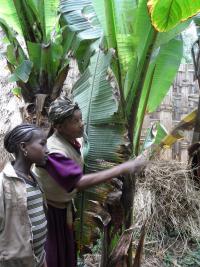
Dr Elizabeth Ewart recently secured a grant for US$80,000 from The Christensen Fund to work together with Dr Wolde Tadesse on a project based in southern Ethiopia. This grant follows on from John Fell Fund seed funding obtained in 2016.The central aim is to produce an ethnographic account of the socio-cultural significance of enset (ensete ventricosum), which is a key staple crop cultivated in the highlands of Ethiopia. Enset provides food and other materials to several million Ethiopians and their animals. Across the highlands, rural and many urban homesteads are visually characterized by the tall, dark green, shiny enset groves that normally surround the main house and serve as visual markers for the well-being of the household. The resilience of the crop along with the durability of food products derived from enset have led to some people calling it the 'tree against hunger'. However, ethnographic research with local communities shows that the importance of enset goes well beyond the staving off of hunger and is rather understood as a ‘tree for living well’. Enset is thus not just nutritionally but also culturally central to local understandings of wellbeing.
A further purpose of the project is to place enset within a wider cultural ecology that links crops (including barley, bamboo, enset, potatoes) to land, people, and their animals. Thus enset is part of a wider agro-ecological landscape that is at once resilient and sustainable. In this landscape, nutrition and cultivation can be understood as mutual flows of sustenance. For example, manure flows from animals to enset, while enset in the form of animal feed returns sustenance to animals.
Overall, the project aims to contribute to an account of highland agricultural practice that seeks to decentre human agency, recognizing instead the multiple ways in which land, animals, crops (including cash crops), forests, and people mutually co-create one another.